Feature
Memories of Maine Road from the Man City fans who were there
Manchester City: a journey of peaks and troughs
Published
1 year agoon

Let’s take a nostalgic look back on memories of Maine Road from the people who were there.
Concealed within the heart of a housing estate in Moss Side, sat the former home of Manchester City Football Club, Maine Road — named so after the road that ran past its western boundary.
Manchester City lived there for 80 years, from 1923 – though the club was founded in 1880 and was originally based in Gorton and Ardwick. The final game before the closure of the stadium took place on May 11th 2003, with a Premiership match against Southampton Football Club.
These days the site that once held many great games — and plenty of shit ones too — with goals to remember, many great footballing legends, and heard the echoing chants from home and away fans, has now been completely bulldozed and replaced with a modern housing estate.

Before a number of infamous rough years, City were a huge and successful club, as Dr Gary James a football historian and City fan recalls: “I was born when City last won the league title, and they won all sorts of trophies in the late sixties and start of the seventies.
“And so, my very early years were: Manchester City was a giant club. I remember the 1976 league cup final. It felt as if this was always going to be this major, prominent club.
“And then, we had to wait from 1976 to 2011. There were relegations, there were struggles, things fell apart.”
For long-standing City supporters, it’s been one hell of a rollercoaster ride to be on, as he continued: “When City was first relegated in 1983, I was devastated. But it made me want to support my club even more.

Manchester City secretary Bernard Halford and club historian Gary James visit the derelict Maine Road site 05/04/04.
“There was always a thing about City; it was peaks and troughs. City represented life; we have great moments in our lives and we have some pretty awful ones.”
Now City reside in the Etihad Stadium, just east of the city — but we’ll get to how they got here later. As Dr Gary James says: “The history of football is important so that we know where we are today and how we got here, and perhaps learn from the past and so on.”
Growing up in Manchester, you have to pick a side and stick with it. Are you a Red or are you a Blue? From then on it’s ingrained into your very being and you remain loyal to your side no matter what.
On the geographical boundaries of Manchester and how it adds to the rivalry between City and United, Dr Gary James said: “I feel sorry for those cities that don’t have two prominent clubs, it’s like they’re missing something. If you’re from Manchester, you know where the border is.
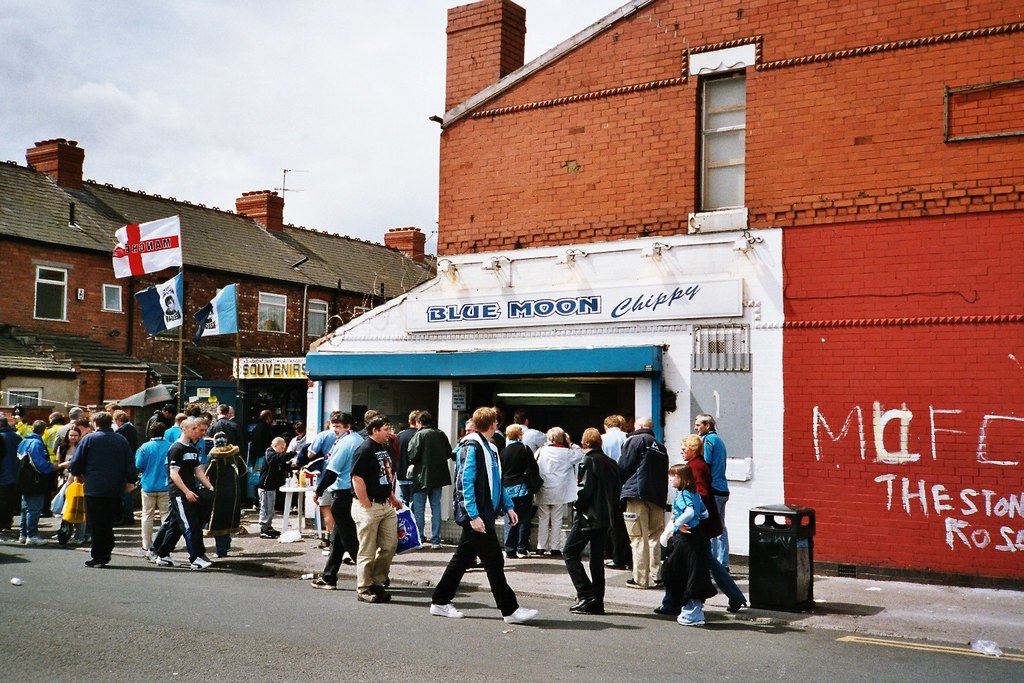
“Visitors to Manchester just don’t understand it but if you’re from Manchester you absolutely understand it.” In club rivalry, even the finer details matter.
During the Maine Road days, supporters would find a place to park on the streets of the residential area that surrounded the ground — lined with rows and rows of Victorian terraced houses — as legions of fans on foot and donning blue scarfs would be cutting through entryways and up streets.
As Blues pulled up in their cars filled with friends and family members excited and nervous but ready to watch a live game, young lads on bicycles would approach drivers and ask for a quid to ‘mind your car’.
It was a fair exchange, after all, this was the housing estate they had to live on and it must’ve been frustrating having hundreds of fans parking their cars outside your house and filling your streets every week. It was also a great way to earn a bit of pocket money for local kids in a working class area.

Dr Gary James remembers: “My dad used to work for Coca-Cola, and when you parked up anywhere on one of the side streets and, ‘Can I mind your car mister?’ — it always happened.
“He had a van from Coca-Cola, with logos all on the side. We got out of the van and inevitably loads of kids were waiting, ‘can I mind your car mister?’. So my dad actually said, ‘If you’re here when I come back, you can have some Coke’.
“So, we went to the game and normally, when my dad said something like that then nobody would be there when we got back. You know what it’s like, you get the money at the start and you’re not going to hang around.
“When we got to the car, this lad — he was only about four or five — he just stood there, ‘I minded your car mister.’ So my dad got a bottle of Coke out and gave it to him.”
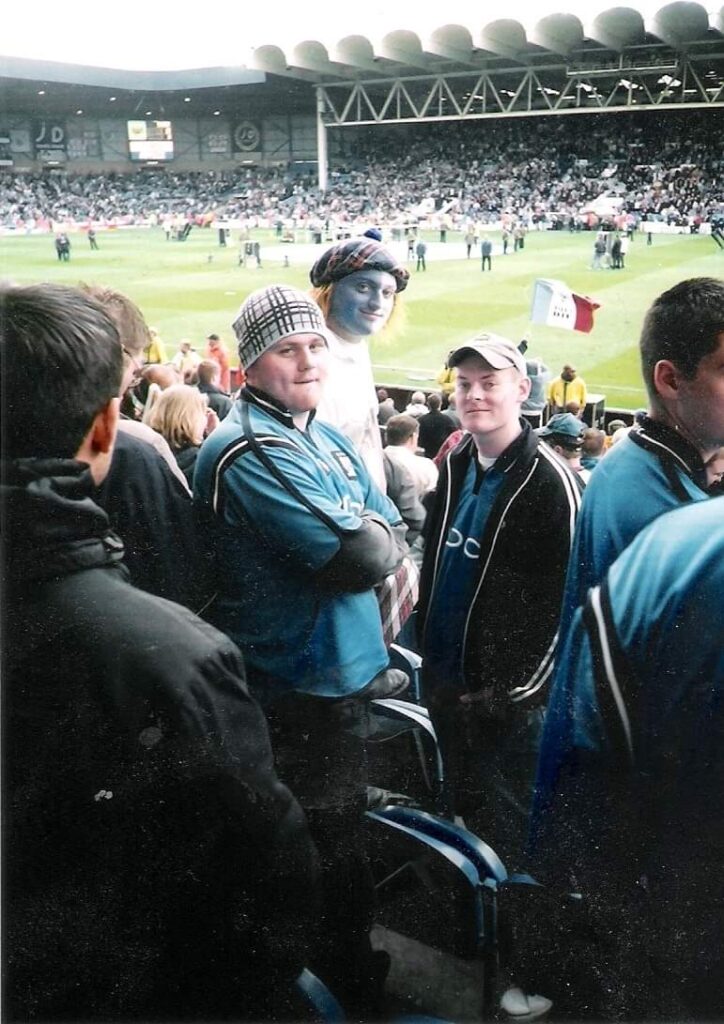
Inside the ground, Maine Road was made up of four different-sized stands built over a number of eras. There was the Main Stand, the North Stand, the Umbro stand and the Kippax. Each stand attracted a different kind of supporter looking for a certain match day experience.
“When I was a kid we used to sit in the Platt Lane stand, it was behind the goal and it was wooden benches that had been put onto the original terracing,” Dr Gary James said. He described it as having very shallow terracing so it was difficult to see anything, but ‘there was a weird excitement about the place’.
About the Kippax Stand, Dr Gary James said: “It sort of became the place where you had to be if you wanted to make some noise. There was a particular area of the Kippax which was known as Chanter’s Corner.
“I remember the first time I experienced that mass of people and it was passionate, it was noisy, it was incredible.”

Anthony — known by many as ‘The Ginger Wig’ — started going to games from 1991. When he was 12, he was classed as an ‘adult’ and so was able to finally sit in the Kippax Stand with his friend.
He described some funny memories in the stand, saying: “There was a famous chicken guy. I think he was a chef. He would pull a raw chicken out and start whirling it around and putting it on his head.”
Speaking about how he earned his nickname, he said: “Last match of the season was always fancy dress. I wore my hat and would go like Braveheart with a painted face and kilt.”
He bought the hat while on holiday to Scotland in 1998, a season in which City didn’t win very often, he continued: “But first game of the ‘98/99 season I wore it and we won 3-0. All the season ticket holders around me said, ‘you’re going to have to wear that again’. I’ve worn it for every match for 24 years.”

As well as fond memories, there were some dark days too. Dr Gary James continued: “For many years, we were demonstrating against the chairman, Peter Swales, because to be frank, when Peter Swales took over, all plans to invest in the stadium… went.
“As time went on the club was put into debt, the opportunity to win trophies vanished, the stadium started to fall apart and managers were just sacked, or walked out. From 1983 onwards, for me, demonstrations became a key part of going to Maine Road.
“So, you’d be watching the game, City would lose, and then you’d leg it off the Kippax Stand, round the stadium to the forecourt in front of the North Stand, for a demonstration — not every game, but a lot of games.”
After much disillusionment with Swales, City legend Francis Lee, who was also a successful businessman, came in and took over the club. He made some positive changes for the club, but many fans believed that his big error was sacking Brian Horton and bringing in his friend, Alan Ball. Dr Gary James said: “None of us were encouraged by that.”

The Ginger Wig recalled some dark but funny memories from those times, saying: “The season we got relegated from the Premier League — that was my first relegation. Steve Lomas took it [the ball] to the corner because everyone had heard that we only needed a draw.
“Niall Quinn had been taken off. He was 6ft 4in and gangly. You saw him galloping up the touchline saying, ‘No! We need to get a goal!'”
On weekends, players could be seen training at Platt Lane. Fans would go down to watch their idols participating in a session, kicking a ball around with other teammates. Paul Walsh’s long hair blew behind him as he ran for the ball. Niall Quinn was easy to spot, being so tall.
I remember my mum laughing as she overheard Michel Vonk saying ‘I have nothing to lean on’ in his Dutch accent, while signing autographs, and so a fan offered their back for him to scribble on. Before players left to enjoy the rest of their weekend, Georgi ‘Kinky’ Kinkladze could be spotted getting into his sports car to drive off — like a total superstar.

City stars from years gone by could be seen training the next generations of City players including the likes of Asa Hartford — who was assistant manager during the Franny Lee and Alan Ball era in ‘95.
John Burridge aka ‘Budgie’ was a well-loved goalie who only had a short stint at the club (1994-95). I remember my dad took my brother and me to Maine Road to pick up some match tickets and then over to watch the players train at Platt Lane — something we would sometimes do.
One particular day it was raining heavily and on the way after collecting the tickets, dad spotted John Burridge carrying a huge bag filled with footballs — the rain was bouncing off him.
He pulled over, in the black Seat Ibiza we had at the time, and shouted: “Budgie! You going to Platt Lane? D’you want a lift?” Budgie stopped and looked over: “Oh, yeah mate. I wouldn’t mind,” he said, relieved. I couldn’t believe we had a City goalie in our car.

City moved into the then-named City of Manchester Stadium in August 2003 and Maine Road was no more — after plans of its expansion were abandoned in favour of the move to the new site. The Ginger Wig said: “I remember the man in front of me took his cigarette lighter out and burnt his seat off, and took it with him.”
My mum and dad described how while fans were leaving the ground after the last ever game, they would stop to look back at it for one last time. “It was just a weird feeling,” my dad said.
In 2007, the former Prime Minister of Thailand Thaksin Shinawatra announced his take-over of the club from John Wardle, and brought in Sven-Goran Eriksson to manage the team. Many fans were hopeful that things could be looking up, though there were mixed feelings.
Then, in a bigger shock, on September 1st 2008 Manchester City were taken over by Sheikh Mansour bin Zayed Al Nahyan’s Abu Dhabi United Group (ADUG).

Dr Gary James recalled: “I got a phone call from Gary Cook to come down to the stadium because he wanted me to talk to someone about the history of the club. He wouldn’t tell me who it was.
“I went down there and after ages, Gary Cook arrived. He said, ‘I’m gonna take you to meet someone. This guy is called Khaldoon Al Muburak and he’s going to be the new chairman of Manchester City, and he wants to ask you some questions. Tell him the absolute truth. Tell him how bad things are’.
“Khaldoon got a notepad out and a pen and he said, ‘I want to ask you some questions’. He said, ‘the first question is how and why was this football club created?’ I thought, ‘wow’.”
The Ginger Wig said: “It was crazy. On Sky Sports News it said we were in for getting all these players. I was thinking, ‘where’s all this money coming from?’ I was glued to Sky Sports News that day. We went from having no money, to being like the richest club in the world. It was just amazing.”

Since the the Abu Dhabi takeover, City have morphed into the ‘super club’ everyone knows today, under manager Pep Guardiola. They’ve won a number of trophies including the Premier League (six times in recent years and twice in the old league). Just recently, the club submitted a planning application for a £300m expansion of Etihad Stadium, to increase the current capacity from 53,400 to 60,000.
It’s great to see the Blues taking home silverware after years of not winning anything at all. To see life-long supporters, including your parents, finally get to witness glory years for the club is just amazing.
But looking back through the years, even when things were bad, it was still a great feeling to be a City supporter. I guess we had something to fight for, never really knowing we’d some day finally get there.
Asked if he’d still support City if we went back to having no money, The Ginger Wig said: “Yes. The fact that they’re rich and have the best players in the world is just an added bonus. If they were playing in the park across the road, I’d still watch them. It’s just ingrained in you.”

Asked who his favourite all-time player is, Dr Gary James said: “Pablo Zabaleta. A legendary figure in my eyes. Before Pablo Zabaleta it was Dave Watson.” The Ginger Wig agreed, saying: “Pablo Zabaleta. He was just hard as nails, and just the stories of him coming in and learning English by watching Coronation Street.”
For my dad, it’s Dennis Tueart: “He was fiery and he scored goals. He could turn a game.”
For my mum it’s Shaun Wright-Phillips, because, she says: “He was the one skilful pass, goal-scoring player. He was like a ray of hope and he came from the youth, and he hung on to us for a long time.” — Shauny Wright is mine also.
You can follow Dr Gary James on Twitter @GaryJamesWriter. He has written numerous books about the history of football. You can also follow Anthony @thegingerwig on Twitter. He sells City memorabilia and gifts — look out for him wearing his ginger wig to the game on match days!
You may like
-


Manchester Flower Festival returns with tributes to Sarah Harding and Caroline Aherne
-


Billie Eilish announces FOUR Manchester shows as part of world tour
-


Popeyes opening new drive-thru in Manchester tomorrow with FREE chicken
-


Memories of demolished Trafford Park Bakery from the people that worked there
-


Popular Italian launches new menu with fresh cheesy pesto pasta and king prawns
-


Epic indoor inflatable park reopens with huge new ball pit filled with nearly half a million balls
Feature
Memories of demolished Trafford Park Bakery from the people that worked there
From bomb threats, to falling asleep on conveyor belts, to eating space cakes – fun times and sad times happened here, until one day it was all over
Published
3 months agoon
April 19, 2024
Trafford Park was once home to a huge bakery where workers would ‘get up to no good’ but still ‘get the job done’, until one day it closed for good. Here’s their tales from the Trafford Park Bakery days.
It once stood on Ashburton Road West in the industrial maze that is Trafford Park, until it was torn down in 2008.
The bakery was known for offering well paid jobs to people living in the surrounding areas, attracting workers from Eccles, Urmston, Stretford, Salford and Stockport, as well as a number of agency staff.
When the recession happened in the 1980s, a lot of tradespeople found themselves out of work, and for a steady income many of them took up employment at Trafford Park Bakery.

Ex-United defender Bobby Noble also got a job there. He had to retire early from football at the age of 23 after he was injured in a road accident, which damaged his sight and the ability to judge the flight of the ball.
He played among the likes of Best, Law, Stiles and Charlton and helped the team achieve League title victory in the 1966/67 season. Sadly, Bobby passed away last year, but his former colleagues remember him as ‘a lovely man’ and ‘funny guy’ with ‘great stories’.
Employees enjoyed the times they had at the bakery with their mates so much, they even set up a Facebook group after it closed down called ‘Trafford Park Bakery…They think it’s all over! It is now….’ to stay in touch and remember the best times.
Clare Callaghan got a job there after previously doing part-time work to fit around her children.

About how she came to work at the bakery, Clare says: “I’d never had a job like that before, I always worked in pubs, cleaning and doing school dinners – whatever fitted in with the kids.”
But when Clare’s kids got a bit older and went to school, she looked for full-time work and landed a job at the bakery as a quiche assembler.
She remembers: “I’ll never forget walking along the high corridor with glass windows on each side so you could see the production areas. And then you walked over to the assembly area where they actually made the stuff and all the machines were on and I thought ‘oh my god’, you know, it looked like Willy Wonka’s.”

Describing her job, she said: “So there was a conveyor belt and four girls on scales putting peppers and goats cheese on the quiches and then I topped them off with parmesan cheese. So I was just stood there sprinkling parmesan all shift. Sometimes my eyes would be closing.”
About the people she worked with, Clare said: “Every line was fun but our line was good fun. It was a mixture of younger and older women and men.”
Clare was quickly made the new line leader ‘in no time’ after one person got sacked and another moved to nights after photos of them ‘misbehaving’ at work fell into the hands of senior management.
Mike Minshall trained Clare up to work in the quiche department when she first started.

On how he found a job at the bakery, Mike said: “I actually found out through one of the national papers – my wife told me.
“And I applied and one of the daft questions was: ‘If we made nuts and bolts and we did 10 an hour, how many would we do in eight hours?’ In my answer, I put: ‘I thought you made pies?’
“The girl interviewing me was called Janet and she went: ‘Right, you’re in because you’re the only one who’s given me a daft answer’.”
Mike recalled his first day on shift, saying: “On my first day at work, I met my boss Pete – who I thought the world of. I went, ‘what do I have to do?’, he went, ‘lean against that wall’. I went, ‘what?’. He went, ‘lean against that wall and every time he [one of his colleagues] walks past, say knobhead.’”
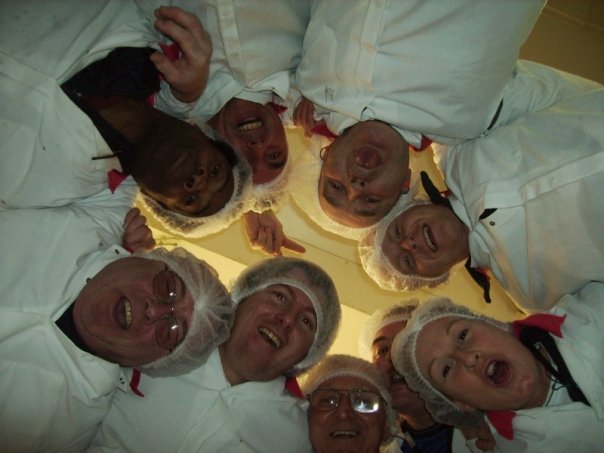
“So I asked why and he told me that the guy was asked to clean the machine and he put a hose pipe in the panel and blew it up.
“He told me that was my job for the day; to lean against the wall and call him a knobhead.”
Remembering other hilarious happenings, Mike said: “My friend fell asleep on a conveyor belt and he was lucky he didn’t get dropped into the pastry cutter. He was on the hygiene team.
“One time, I walked into my department and this gentleman is there on his back in a machine that we wash the trays in, having a cigarette because it had an extractor fan. He’s lucky it was me.”

“There’s all sorts of different stories, there were affairs going on – there were 800 people who worked there,” he continued.
As Mike also recalled: “Our taps were touch sensitive so if you brushed past the tap it came on. So, this gentleman was telling someone who couldn’t work the water, ‘you have to be more assertive and say, water, as you brush past the sensor’.
“So this lad kept saying ‘water’ and getting told it’s not working because he needs to be more assertive when he says it.
“After 20 minutes this was guy was shouting ‘I want water, give me the effing water!’ When all he had to do was brush it.”

R worked at the bakery from 1988 on the Hygiene Department doing night shifts. He was also a line leader.
Remembering one funny incident, he said: “I remember one day the boss walked in while we were in the middle of working and told us that an animal rights organisation had been on the phone and issued a bomb threat to the bakery.
“So we were like ‘right’ and started to put everything down and make our way out of the door. But the boss was like ‘no, not yet, it’s not until 1 ‘o’ clock, carry on with what you’re doing’.
“We were all just laughing at him and was like, ‘I don’t think so’ and carried on walking out.”
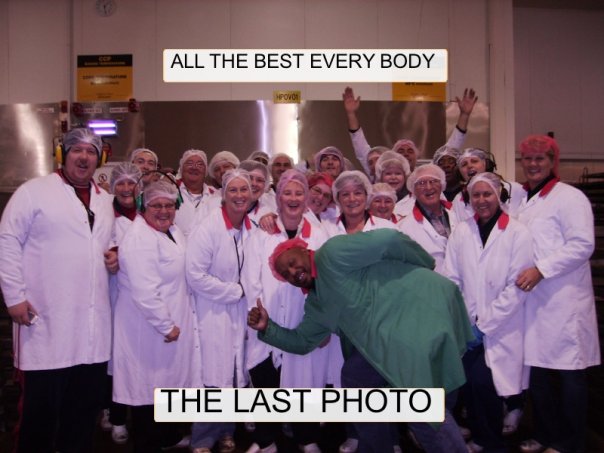
Another time, R recalled a new lad staring on his line who was a ‘hard worker’ and so he mentioned to his boss to help make him feel welcomed so they could keep him working on their line.
He offered the new lad a lift into work if he was ever stuck for getting in. A number of weeks went by until one particular morning, the lad did call R before work and asked if he could pick him up on route.
He told him his girlfriend’s ex-boyfriend had spotted him and was chasing him around the streets and so he was hiding in some bushes.
“I said ‘no problem, mate’ not thinking anything of it,” R said.

R pulled up and the new lad jumped in and was keeping his head down. R continued: “I told him ‘there’s no need to worry now, you’re in the car. But as we were driving in the car lit up and I was like ‘why’s the car lighting up? Is that a helicopter?’.
“Anyway, we got to work and I didn’t think anything of it. But later on my manager pulled me and told me I had to tell the new lad he was needed at the nurses’s station.
“They told me not to tell anyone and to keep it to myself. Straight away I knew what they meant and so I told him to go to the nurses station and police came to take him away in handcuffs.
“He was a really nice lad and a good worker, but it turns out he was a car thief too.”

Clare remembers another time when someone brought in ‘space cakes’ on a night shift and that one of the guys on the line ate one ‘and his head nearly fell off,’ she laughed.
The fun times kept on coming as people made friends for life at Trafford Park Bakery, until one day, news broke it was closing down and those good times would become fond memories etched in the minds of those who once worked there.
On his time at Trafford Park Bakery, Mike said: “I loved every minute of it there and if it was still there, I’d still be there. I worked there for 10 years before it shut. When it was closing down, I was told before everyone else. But it was announced on the BBC before they told everyone.
“My late wife rang me and told me ‘you’ve all lost your jobs’, and we were told to not talk to the media or you could jeopardise your redundancy. I miss my team. People move on but I do miss people. I miss the Christmas dinners there because the senior management had to serve you, and I’d be bossing them around.”

After the bakery closed, Mike went to work for Peugeot but didn’t like it. He then went back to ‘what I was good at’, which was repairing wagons. But he said he ‘didn’t like getting full of oil’. He then went to work for Rivita and West Mill at Trafford Park but is retired now.
He added: “I’ve had an interesting time but the best time was when I was there [at Trafford Park Bakery] with that lot because they were all crackers.”
About her time working there, Clare added: “It was ace. I mean, we got the work done, and everyone used to moan about the place but it didn’t matter what shift you were on, you knew everyone – it was just brilliant, you could make a television series out of it.
“But I mean, some of the things I couldn’t repeat!”
Clare still keeps in touch with Barbara who worked on her line and goes to visit her sometimes for a catch up.
Feature
Remembering Manchester’s lost underground market that now lies empty beneath the city
Do you have memories of shopping in the underground Market Centre?
Published
4 months agoon
March 14, 2024
Manchester used to have an underground market that now lies abandoned beneath the city centre.
If you walk along Market Street, you’re walking above what used to be the Market Centre – an underground shopping area filled with stalls and units selling music, clothes and a variety of other essential and non-essential items.
The underground Market Centre opened in 1972 and was a busy and bustling shopping emporium, much like the Arndale and Market Street both are today.

Punks would shop there for outfits, music fans could browse through the vinyl record shops and buy tickets to gigs at Piccadilly Box Office. It even had a Stolen from Ivor – which was the first place in Manchester to sell the jeans brand Levi’s, and where many would flock to get their hands on a pair of 501s.
Fashion addicts could hit up shops including Roxy, Oasis and Justins as well as a number of other boutique stalls, including the leather shop, for cool jackets.
DJs could sift through the collections at Underground Records Import and fans could shop at iconic music stalls including Collectors Records, Yvonne’s Record Stall, and the Spinn Inn Disc Centre.

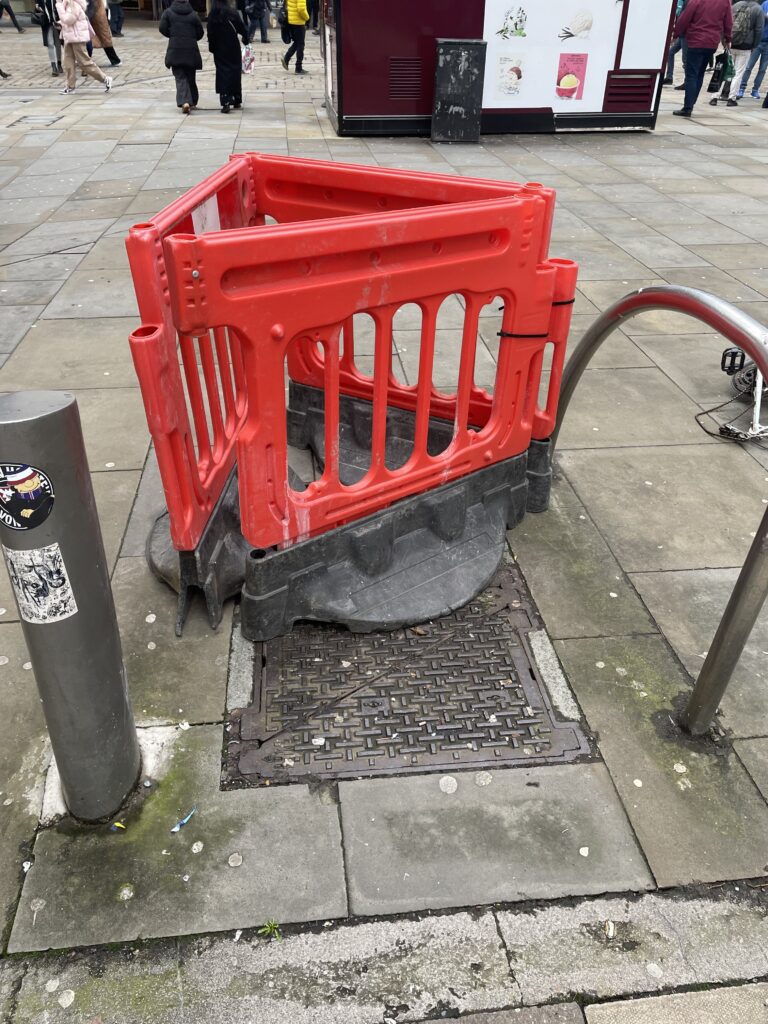
The Market Centre was the place to be throughout the ‘70s and ‘80s until it closed down in 1989.
The entrance to it was located on Brown Street, with two other entrances on Norfolk Street and Spring Gardens. It had escalators going down under the pavement that led to this total treasure trove.
If you head to the Tesco on Market Street and go down to the lower level, you’re actually in what used to be part of the underground market.
But now it has fallen into disrepair, with the odd urban explorer who has dared to delve into the depth of the city to see what remains of this now eerie, decaying ghost market.

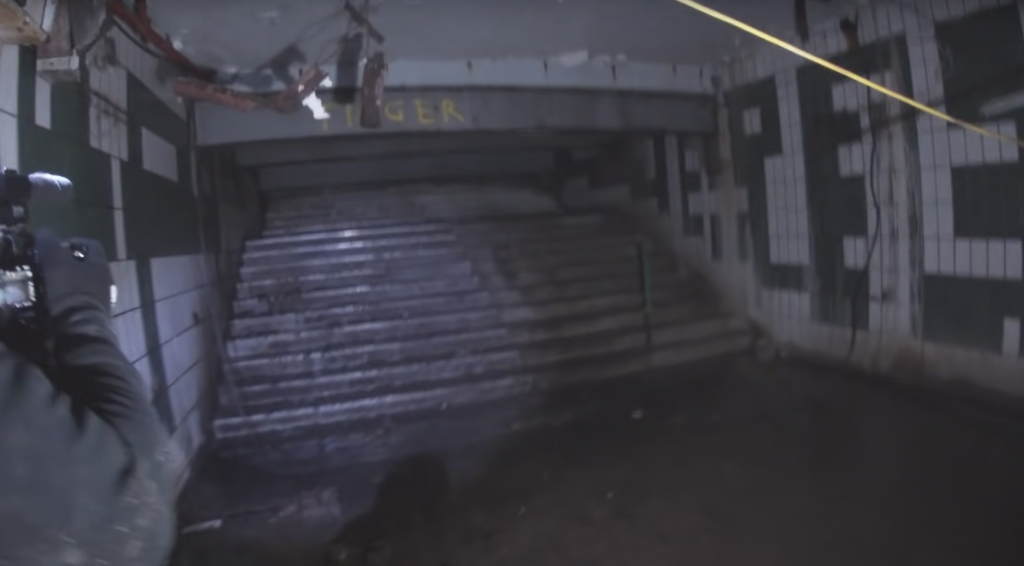
One explorer, known as Urban Sherman on YouTube, went down to have a look at what’s left of these once bustling underground stalls. Finding a way into where the old main entrance was located, down by the side of Tesco behind the food trailer, he climbs in and lands on the old steps with tiled walls.
As torches light up the dark depths of the city, we can see wires hanging, rubble strewn across the floor, graffiti on walls and one rusty sign that reads: “factory prices.”
It appears a wall of breeze blocks has been put up to block off any entry along the halls of the former market with the rest of it inaccessible, only to live on in the memories of those who once shopped there, and in old archived photographs.
Got a story to tell?
Have you got a story or video you think our audience will love? We want to hear from you, drop us an email on submit@propermanchester.com and we’ll get back to you.
Feature
The legendary nightclubs that Mancunians would most like to bring back
Remember any of these?
Published
5 months agoon
March 8, 2024
We asked our readers which nightclubs that no longer exist they would choose to bring back – and we got some great answers.
If you could choose just one, which would it be?
Here’s a list of former nightclubs that people would love to see return, as chosen by Proper Manchester readers.

The Boardwalk
The Boardwalk was a nightclub based on Little Peter Street in Manchester which was open from 1986 to 1999. It was a multi-floor nightclub, gig venue and rehearsal complex all in one.
It’s where Oasis played their first ever gig in 1992 and saw many notable bands that were a part of the Madchester music scene, including the likes of Inspiral Carpets, Doves, Happy Mondays, James and more. These days, it’s used as an office space.
There’s a blue plaque bolted to the wall which reads: “Remember me. I was something once.” It has a yellow smiley face in a nod to the Madchester acid house era.

Club Phoenix
Located on University Precinct, on Oxford Road, this sweatbox of a student dive would have music blaring on different nights, playing everything from indie bangers to dance classics and everything in between.
It was a scream club filled with young students looking for cheap drinks and cheap thrills too. There were plenty of messy drunken shenanigans. Being close to the Academy, it would be a great place for the young ‘uns to go for pre-gig bevvies.

The New Continental Club
The New Continental Club was on Harter Street, Manchester and opened in 1967. It was affectionately known as The Conti. It closed in 2001 and became The Tube nightclub, which has also since closed.
Many nurses and frontline emergency services workers frequented The Conti and many say they experienced some of the best nights out of their lives.
The narrow staircase would lead down to the basement club, food would be served through a hatch and the queues to the toilets could be as long as your arm – they were pretty minging too.

Discotheque Royales
Built in 1845, the building was originally made to be an amphitheatre. But in 1921 it was changed into a cinema after facing stiff competition from the Palace Theatre and Opera House.
After being used as a bingo hall, the historic landmark then became one of Manchester’s most iconic nightclubs known by most as ‘Royales’, since 1989. In later years it went on to become Infinity and M-Two but Royales was legendary throughout the ‘90s.
Inside, it had many levels and a huge dance floor that was meant to look like it was lit up under a huge chandelier. With long draped velvet curtains, lights and reflective mirrors everywhere, it was party central.
DJ Brutus Gold held Love Train nights there until the show moved to the Ritz in 2000.

Fifth Avenue
This club started out as Legend, which became known as Manchester’s ‘other club’ during the ‘80s and the height of the Hacienda era, and saw top DJs who also played nights at Wigan Pier.
When it became Fifth Ave it was transformed into an indie music haven. As revellers walked down into the dingy basement and the whiff of cheap bleach in the air would hit them in the face, some of the best tunes from Manchester bands would be blasting, as partygoers walked straight across the sticky floor to the bar where they’d order a drink served in a plastic cup.
Club-goers soon got to know that if you went up to request a song from the DJ, it wouldn’t get played. In later years, it became known simply as Fifth, after owners tried a bit of a refresh.
But as the pandemic hit, the club sat empty and shuttered, and sadly never to return as it closed for good in 2021.

Twisted Wheel Club
It quickly became a Manchester institution after opening in the ‘60s, attracting mods across the North looking for somewhere to dance all night to rhythm and blues.
Before Twisted Wheel, clubs would play mainstream popular music. This Manchester establishment was groundbreaking and paved the way for how nightclubs would play different music genres to suit various tastes in the future.
Twisted Wheel, based on Swan Street, was a legendary haven for Northern Soul enthusiasts. It closed for a while in 1971, being renamed Placemate 7, then Follies. The club closed for good in 2021.

Thunderdome
If the Hacienda was too pretentious for you, or you got turned away at the door, there was another legendary Madchester club playing all the great acid house music buzzing dancers wanted to rave the night away to – it was called the Thunderdome.
Located at 255 Oldham Road, this club was all about the music. It was edgier, full of all walks of life and was even home to some of Manchester’s criminal underworld. Many fondly referred to it as the ‘Dome.
Initially, although it felt a bit dangerous, nobody wanted any trouble, they just wanted to get off their trolley and enjoy the music. But over the years there were police raids and even helicopters circling the club as well as undercover officers wearing yellow smiley face T-shirts mingling in amongst the hooligans, gang members and just generally dodgy people.
Unfortunately, its rough reputation has stuck with it to this day, while the Hacienda is remembered most as the epicentre of the Madchester acid house scene. The Thunderdome was demolished in 2010 but its legend lives on in the memories of retired ravers and on tribute Facebook groups.
Find something to do in Manchester

Huge beer festival with more than 500 different varieties coming to Manchester

New makers market with everything from dog accessories to house plants and jewellery coming to Manchester

New apartment development with huge gardens and outdoor space opening this year

Stagecoach hiring over 100 new bus drivers for Bee Network with £31k salaries

Manchester Flower Festival returns with tributes to Sarah Harding and Caroline Aherne





